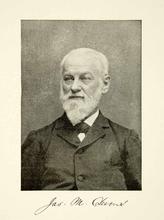James M. Deems: UVA Music Instructor and Union Army General
by Ian Iverson
James M. Deems was born in Baltimore, Maryland on January 5, 1818, to Colonel Jacob Deems and his wife Susannah. Born into relative prosperity, James inherited with a strong military background. His grandfather, Frederick Deems, had served in the Continental Army throughout the American Revolution and his father had commanded a company of Maryland Infantry during the War of 1812 before pursuing a career in local politics as a National Republican and Whig, serving for a time as city collector. Deems first displayed his musical talent as a military bugler, but he quickly picked up a variety of instruments under the direction of Captain James Rountree and had mastered the clarinet and French horn by the age of 13. Eager to pursue a career as a musician, Deems traveled to Dresden and studied under the famed German cellist and composer J.F.F. Dotzhauer. Returning to the United States in 1841, Deems began teaching music and composing in Baltimore, where he married Mary Isabelle Flack in 1844.1
In 1848, Deems became the instructor of music at the University of Virginia, taking over from Jacob Bigelow, who had held the post since the University opened in 1825. Although formally recognized as an instructor by the faculty, Deems did not draw a salary from UVA. Instead, he made his living from lesson fees and from his secondary role as a teacher at the Albemarle Female Institute, a private academy for young women in Charlottesville. Becoming friends with long-standing professors such as Gessner Harrison, Deems and his wife prospered in Charlottesville and raised a family in the community. Amid rising sectional tensions, Deems pushed back against the Southern nationalism endorsed by UVA students and faculty alike, composing a Unionist anthem titled “Our National Flag” in 1857.2
In 1858, Deems resigned his place at UVA and departed on a European tour, returning to the United States as the sectional crisis reached its climax. Deeply committed to the Union, Deems wrote more patriotic anthems in the lead-up and aftermath of the election of 1860. Following the outbreak of hostilities in 1861, he secured a commission as a major in the First Maryland Cavalry. After serving actively as both a field officer and a member of General Franz Siegel’s staff, Deems received a promotion to Lieutenant Colonel and took command of the regiment in the spring of 1863. He would lead the First Maryland through the bloody campaign which followed, including the Battle of Gettysburg, before chronic rheumatism forced him to retire from active service in November. Returning to Baltimore, Deems began giving music lessons and worked as a professor at the Maryland Institute, though he briefly took to the field again during Jubal Early’s 1864 raid into Maryland. In 1867, in recognition of his wartime service, Deems received a promotion to Brevet Brigadier General dating from March 13, 1865.3
In the years after the war, Deems continued his career as a musician and instructor, operating an independent studio in Baltimore for the next three decades. All the while, he remained active in local politics as a Republican and in veterans and memorial organizations, including the Loyal Legion of the United States. His contributions were subsequently recognized by a monument at Gettysburg to Deems and his troopers of the First Maryland. Deems died in Baltimore in 1901, survived by several children, including his son Captain Clarence Deems, who had continued the family military tradition by attending West Point and serving in the Spanish-American and Philippine-American Wars.4
1. John H. Eicher and David J. Eicher, Civil War High Commands (Palo Alto: Stanford University Press, 2001), 205; Joseph A. Bomberger, “James A. Deems,” Groves Music Online, Oxford University Press; The Baltimore Sun, July 15, 1841; The Baltimore Sun, October 15, 1844.
2. Faculty Minutes, of the University of Virginia, October 4, 1848, http://juel.iath.virginia.edu; Maria Carter Harrison to Mary Stuart Harrison, January 9, 1848, Harrison Family Papers, http://juel.iath.virginia.edu; The Richmond Enquirer, August 14, 1857; J.M. Deems, Our National Flag (Baltimore, 1857), https://www.loc.gov/item/ihas.200000989/.
3. The Baltimore Sun, September 2, 1859; The Daily Exchange (Baltimore, MD), July 27, 1860; J.M. Deems and E. Coleman, All Hail to the Union (Baltimore, 1861), https://www.loc.gov/item/ihas.200000986/; James M. Deems, Compiled Military Service Records of Volunteer Union Soldiers Who Served in Organizations from the State of Maryland, War Department, The Adjutant General's Office, National Archives, NARA M985, Roll 4.
4. The Baltimore Sun, June 10, 1865; Der Deutsche Correspondent (Baltimore, MD), June 11, 1888; The Wilmington Morning Star (Wilmington, NC), October 13, 1899; The Standard Union (Brooklyn, NY), April 19, 1901.
